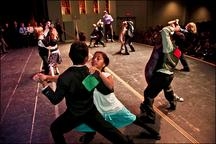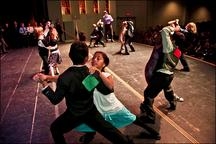
(photo by Brandon Wise)
DOWNTOWN — When ballroom instructor Daniel Ponickly asked a group of fifth grade dancers which number scared them the most, one young gentleman from John Muir Elementary replied confidently, “None of them.”
This fearless swagger was just one of many different emotions that were running through the minds of the students participating in the Ballroom Madness dance competition at Santa Monica High School’s Barnum Hall on Friday.
After 10 weeks of hard work, practice, and countless repetitions, 30 fifth graders strutted their stuff on stage for their fellow classmates, parents, teachers and community members. Out of the over 200 students participating in the dance program in the Santa Monica-Malibu Unified School District, 10 students from each of the three participating schools were hand-picked to participate in the competition based on style, showmanship and overall ability.
The three schools that were represented were John Muir Elementary, Webster Elementary and Will Rogers Learning Community.
Ballroom Madness, a nonprofit organization, aims to support the arts in education by providing fifth and sixth graders the opportunity to learn the art of social/ballroom dance free of charge. The organization was founded by Ponickly and Jane Dorian, two ballroom dancers who met in Los Angeles and shared the passion to teach kids how to not only connect with one another, but to connect with society as a whole.
“This is a Los Angeles, California, home-grown, ballroom, urban program,” Dorian said. “The main goal is to help them build partnership skills, teamwork (and) leadership skills.”
As nervous parents and faculty members shuffled into the auditorium from the mid-morning chill and drizzle, the energized students filled the open theater with booming chants, yells and unabashed joy.
As the powerful Spanish song “Espana Cani” blasted through the sound system, sharply dressed young boys in suits and young girls in elegant long dresses and ruffled skirts promenaded on stage arm-in-arm while their non-performing classmates roared in support.
The 30 dancers were divided into five groups, representing the five featured dances: merengue, foxtrot, swing, tango and rumba. Each group consisted of two couples from each of the three schools, with a total of six couples in each group.
The competition was divided into two phases. During the first round, the five groups performed the dance in which they were assigned prior to the competition. However, the second round brought in the element of surprise because each of the five groups had to demonstrate their versatility by performing a dance style that was randomly pulled out of a hat by one of their group members.
While the boys and girls demonstrated their fiery personalities by side-stepping, twirling, and hip-shaking their way across the stage, they garnered rowdy applause from the audience, especially the eager parents waiting to see the culmination of their children’s dedication.
“It’s truly amazing what these fifth graders can do; it blows you away,” said Joan Krenik, PTA president at Will Rogers Elementary whose daughter was also a participant in the Ballroom Madness program. “They start out not even wanting to dance together, and in the end, they’re tangoing and waltzing; it’s awesome.”
With clipboards and scoring cards in hand, the four judges walked up and down the stage during the performances to rank each couple. The featured judges were Richard Riordan, former mayor of Los Angeles; Julie McDonald, president of McDonald-Selznick Associates; Jordi Caballero, a renowned choreographer that worked with Cher, the Spice Girls, and Jennifer Lopez; and actor Joshua Bitton.
Each couple was rated on a 1-to-5 scale based on ballroom aesthetic, posture, position and their ability to stay on rhythm. Scores for each couple were added together, resulting in a total score for each school.
While scores were being tallied, Ponickly and his dance partner, Mimi Karsh, entertained the audience with an upbeat, Fred Astaire/Ginger Rogers-styled dance routine.
Before announcing the winner, Ponickly acknowledged that regardless of the results, he was proud of each and every one of the dancers, with the audience members applauding in agreement.
The victor, by a mere four points, was Webster Elementary, followed by Will Rogers and John Muir.
“[I felt] confident that I was going to win,” said Benjamin Tran, a dancer representing Webster.
While Tran demonstrated a swagger both on and off the dance floor, his mother expressed an extreme sense of pride in her son’s performance.
“I was so excited when videotaping [the whole dance performance],” said Loan Tran. “All the hip work makes me cry.”
The event ended with all the non-performing members of the dance program from all three schools joining their peers on stage for an impromptu, high-energy electric-slide.
Although Ballroom Madness has only been in Los Angeles for two years, Ponickly has helped out with a similar program in New York. His work with New York kids was even featured in the documentary “Mad Hot Ballroom,” a film that inspired numerous school-age dance programs across the country, including the Los Angeles program, said Ponickly.
The New York dance program went from nine schools to over 200 schools in about two years, and Ponickly hopes the Los Angeles program will have similar results in the next couple of years.
Currently, the program works on a model where the district pays half of the budget and Ballroom Madness fundraises the other half. However, due to budget constraints, only a limited amount of schools were allowed to participate this year.
Ponickly hopes that Ballroom Madness can one day be offered to kids from all across the socio-economic spectrum because he feels that the program offers vital life lessons that will lead to a brighter future.
“This is a final step for them in becoming active, functioning members of society,” Ponickly said. “This teaches kids interpersonal communication skills that they don’t learn anywhere else, and through this, gives them the tools to really succeed.”








